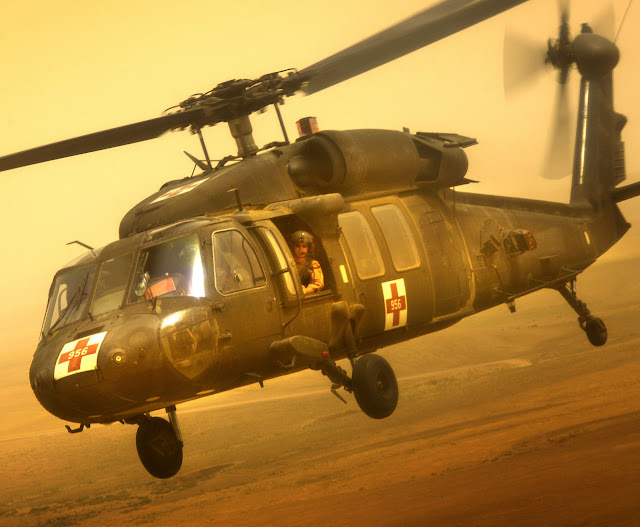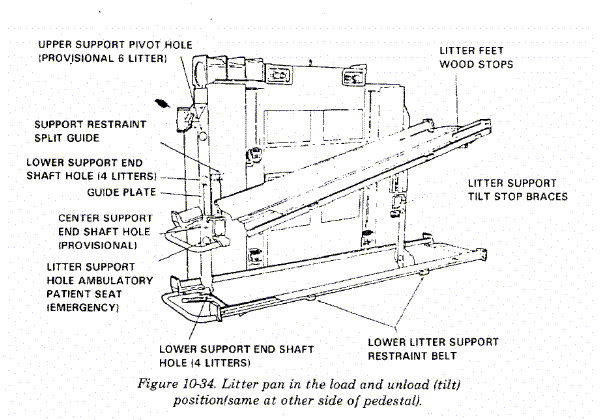El Sikorsky UH-60 Black Hawk es un helicóptero utilitario de carga media, bimotor con rotor de cuatro palas, fabricado por la compañía estadounidense Sikorsky Aircraft y de tamaño medio-grande. Sikorsky Aircraft presentó el diseño del Sikorsky S-70 para la competición UTTAS (siglas en inglés de Utility Tactical Transport Aircraft System) organizada por el Ejército de los Estados Unidos en 1972 para un helicóptero utilitario de transporte táctico. El Ejército designó el prototipo como el YUH-60A y, después de competir contra el Boeing Vertol YUH-61, fue elegido como ganador del programa en 1976. El UH-60A entró en servicio con el Ejército estadounidense en 1978, para reemplazar al UH-1 Iroquois como helicóptero de transporte táctico.
Sus orígenes están basados en los conocimientos obtenidos por los estadounidenses en Vietnam, ya que el helicóptero en sí probó ser un arma muy poderosa a la hora de desplegar tropas en terrenos difíciles.
El UH-1 Huey demostró con creces ser una aeronave que podía usarse como plataforma de apoyo al ser artillado, o transporte y rescate de tropas en el frente; sin embargo, el Ejército de los Estados Unidos comenzó a pensar en un sustituto para este helicóptero, debido a que tenía puntos débiles como los rotores de solo dos palas y un tren de aterrizaje que no estaba construido para soportar aterrizajes de emergencia.
Conscientes de esto, Bell y Sikorsky comenzaron sus estudios; esta última se hallaba más presionada, puesto que Bell se había adjudicado los dos últimos contratos del ejército con el UH-1 Huey y el AH-1 Cobra, con lo cual debía desarrollar un helicóptero que fuera capaz de sobrevivir a los impactos.
El concepto del helicóptero utilitario en combate es que tenga dualidad de los sistemas, para poder soportar el fuego enemigo; fue así como se piensa en una aeronave con mandos gemelos y biturbina.
Además, en caso de un aterrizaje de emergencia inminente, los componentes se diseñaron para sufrir una deformación progresiva, protegiendo el habitáculo del helicóptero; de esta manera se logra un diseño robusto, capaz de soportar situaciones extremas. Tiene dos motores turboeje General Electric T700-GE700, cada uno de 1164 kW nominales. Tiene capacidad de carga de más de 4536 kg.
El Black Hawk fue desarrollado para cubrir un requerimiento del Ejército de los Estados Unidos bajo el proyecto Utility Tactical Transport Aircraft System (UTTAS, Sistema Aeronáutico de Transporte Táctico Utilitario), que buscaba un reemplazo para el UH-1 Iroquois, de enero de 1972. Cuatro prototipos fueron construidos, el primero (YUH-60) realizó su primer vuelo en octubre de 1974, y compitió contra un rival diseñado por Boeing-Vertol, el YUH-61A. Una evaluación preliminar decidió en noviembre de 1975 enviar los prototipos al Ejército para su evaluación. La evaluación condujo a determinar si la aeronave podía ser operada con seguridad por típicos pilotos del Ejército. Tres de los prototipos fueron enviados al Ejército estadounidense en marzo de 1976, y uno fue reservado por Sikorsky con propósitos de evaluación interna. El Black Hawk fue seleccionado y el UH-60A entró en servicio en el Arma de Aviación del Ejército en 1978.
El primer lote de producción del UH-60A fue aceptado por el Ejército en 1978, y entró en servicio en 1979, cuando fue entregado a los Regimientos de Aviación de la 101 y 82 Divisiones Aerotransportadas. Desde entonces, el UH-60 ha acumulado más de 9 000 000 de horas totales de vuelo y ha participado las operaciones principales que el Ejército ha ejecutado, incluyendo Granada, Panamá, Irak, Somalia, los Balcanes, Afganistán y todo el Oriente Medio.
A lo largo de los años, el helicóptero ha sido modificado y mejorado para realizar nuevas misiones y obtener nuevas funciones, incluidas la instalación de minas, la evacuación médica y operaciones especiales.
A finales de los años 80, el modelo fue actualizado al UH-60L (primera aeronave en producción, el 89-26179), que incluía más potencia y capacidad de elevación con la instalación del modelo -701C del motor GE. Un nuevo modelo fue creado, el UH-60M, que extendió el tiempo en servicio del diseño del UH-60 hasta la década del 2020, todavía muestra más potencia y capacidad de elevación e instrumentos electrónicos, controles de vuelo y control de navegación de la aeronave de última generación.
Los Black Hawk pueden realizar un variado tipo de misiones, incluyendo el transporte táctico de tropas, guerra electrónica o evacuación médica. Una versión VIP conocida como el VH-60N es usada para transportar importantes cargos estatales y gubernamentales como congresistas, con el nombre clave del helicóptero Marine One cuando transporta al presidente de los Estados Unidos. En operaciones de asalto aéreo puede transportar una escuadra de 11 soldados con su equipo o un obús M102 de 105 mm con treinta proyectiles y cuatro servidores de pieza en un solo viaje. En otra alternativa, puede llevar 1170 kg de carga interna o 4050 kg externamente. El Black Hawk está equipado con aviónica y electrónica avanzada para incrementar la supervivencia y la capacidad, como el sistema de posicionamiento global.
El coste unitario varía con la versión, debido a la variación en especificaciones, equipamiento y cantidades. Por ejemplo, el coste unitario del UH-60L Black Hawk del Ejército de Estados Unidos es de 5,9 millones de dólares, mientras que el coste unitario del MH-60G Pave Hawk de la Fuerza Aérea es de 10,2 millones de dólares.

































